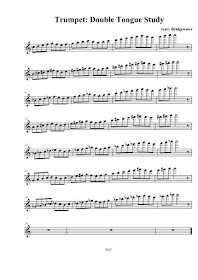Monday, April 30, 2012
Saturday, April 28, 2012
Wednesday, April 25, 2012
Monday, April 23, 2012
Saturday, April 21, 2012
Friday, April 20, 2012
Thursday, April 19, 2012
Thursday, April 12, 2012
Trumpet: Lip Trills (Study One)
Lip trilling is an excellent exercise for improving flexibility, endurance and range. And contrary to what some people claim, it is not necessary to deliver a rapid trill to derive benefit from the exercise.
Start slowly (using a metronome) and add speed evenly as you improve.
Be patient and do not over-practice.
Start slowly (using a metronome) and add speed evenly as you improve.
Be patient and do not over-practice.
Tuesday, April 10, 2012
Trumpet: Hesitancy
Hesitancy in trumpet playing spawns from uncertainty. And players experiencing hesitancy tend to pause before attempting a note. The hesitancy habit is easily formed and can be difficult to break. So it is wise not to form it.
This exercise is designed to help the player gain confidence when moving from lower notes to higher notes and back again. Approach each note with expectation of hitting the note (even if you miss hitting it). And if need be, confine practice to individual systems.
.
This exercise is designed to help the player gain confidence when moving from lower notes to higher notes and back again. Approach each note with expectation of hitting the note (even if you miss hitting it). And if need be, confine practice to individual systems.
.
Saturday, April 7, 2012
Trumpet in Octaves
I had to duplicate existing material while "on the run". So I apologize for any potential mistakes.
Friday, April 6, 2012
Trumpet in Octaves: Study One
Trumpet in Octaves is my 2010 nine studies course for the advanced player seeking to expand their playing range in both directions. Remain on each study until you are able to play it accurately and with ease.
Be patient and do not over-practice.
Be patient and do not over-practice.
Wednesday, April 4, 2012
Trumpet: Study Nine
This study is octave to octave. And the lower note helps your ear establish the higher note's pitch.
Play the exercise as written and use conventional fingering on all notes. Then repeat the entire study single tongued followed by double tongued. If the exercise is too arduous, divide it into separate studies.
Be patient.
Play the exercise as written and use conventional fingering on all notes. Then repeat the entire study single tongued followed by double tongued. If the exercise is too arduous, divide it into separate studies.
Be patient.
Monday, April 2, 2012
Trumpet: Study Eight
An interval is the distance between two notes. And for trumpet players the "distance" can be bothersome if they do not know how to bypass pesky harmonics sounding between notes.
The process takes practice. And it begins by thinking "Hee" as a burst of air is put through the horn. Even on the first attempt, the player should notice a difference in the number of harmonics sounded. But like everything else in trumpet playing it takes practice to perfect.
Though air is released in a burst, it must remain a controlled burst. This is where experience comes to play. And the only way to gain experience is by "doing".
Start the study slowly. Add speed as the intervals become easier to play.
The process takes practice. And it begins by thinking "Hee" as a burst of air is put through the horn. Even on the first attempt, the player should notice a difference in the number of harmonics sounded. But like everything else in trumpet playing it takes practice to perfect.
Though air is released in a burst, it must remain a controlled burst. This is where experience comes to play. And the only way to gain experience is by "doing".
Start the study slowly. Add speed as the intervals become easier to play.
Sunday, April 1, 2012
Trumpet: Study Seven
The notes in this study should flow smoothly from one to the next. Slur beyond (as high as you can) what I have written in the third measure and sustain your high note in the fourth measure.
























